

Compact Muon Solenoid
LHC, CERN
| CMS-PAS-FTR-18-005 | ||
| Study of W±W± production via vector boson scattering at the HL-LHC with the upgraded CMS detector | ||
| CMS Collaboration | ||
| November 2018 | ||
| Abstract: The prospects for the study of W±W±jj final states, produced in proton-proton collisions at centre-of-mass energy of 14 TeV via vector boson scattering (VBS), with the upgraded CMS detector at the High-Luminosity LHC (HL-LHC) are presented. The W bosons are detected via their leptonic decays: W→eν or μν. The results from a study using a full simulation of the upgraded detector along with an average number of 200 proton-proton interactions per bunch crossing are presented in terms of the precision of the cross section measurement as a function of the total integrated luminosity. The significance of the polarized cross section measurement is also discussed. | ||
| Links: CDS record (PDF) ; inSPIRE record ; CADI line (restricted) ; | ||
| Figures | |

png pdf |
Figure 1:
Representative Feynman diagrams for W±W± electroweak production in proton-proton collisions: (left) t-channel Higgs boson exchange, (middle) t-channel Z/γ exchange with triple gauge couplings, (right) quartic gauge coupling. |
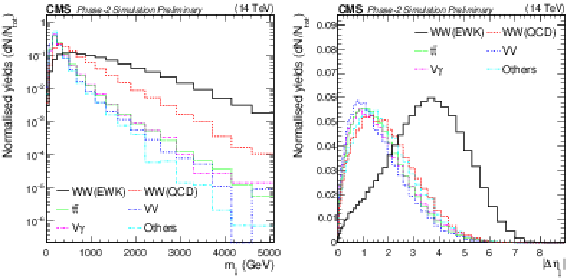
png pdf |
Figure 2:
Shape comparisons for signal and background processes. Left: Invariant mass of the two leading jets. Right: The difference in pseudorapidity between them. |
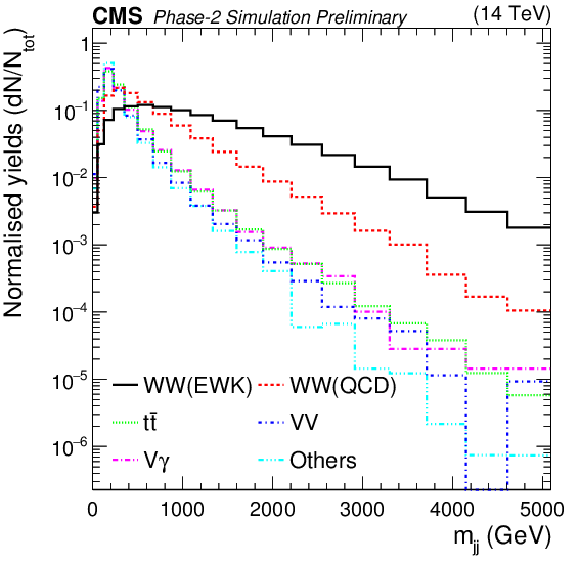
png pdf |
Figure 2-a:
Shape comparison for signal and background processes: Invariant mass of the two leading jets. |
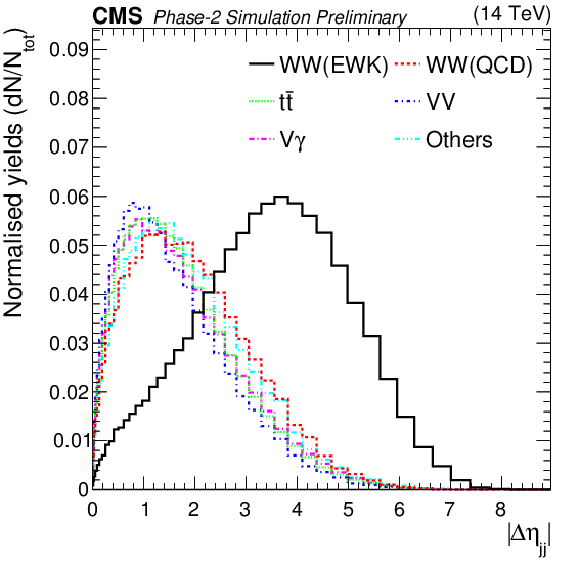
png pdf |
Figure 2-b:
Shape comparison for signal and background processes: Difference in pseudorapidity between the two leading jets. |
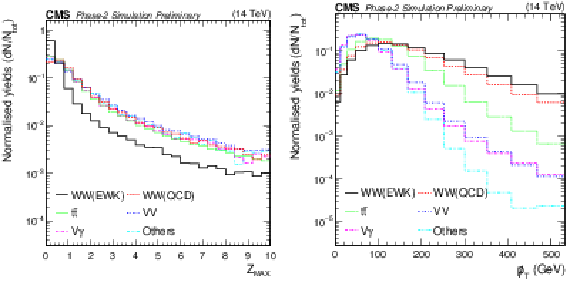
png pdf |
Figure 3:
Shape comparisons for the signal and background processes. Left: The maximum of the Zeppenfeld variable for leptons. Right: Missing transverse momentum. |
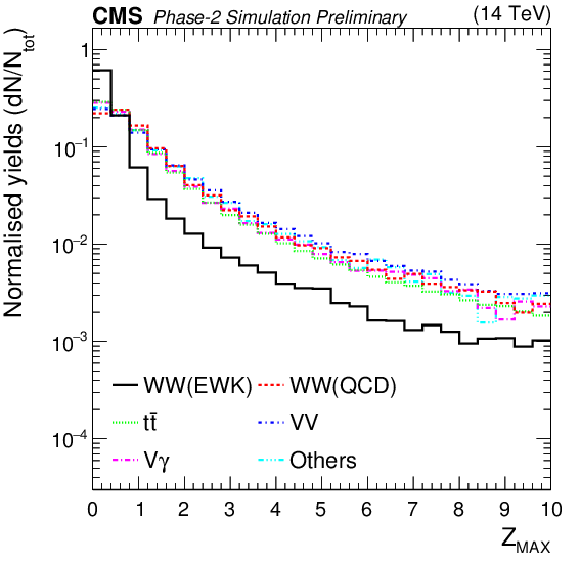
png pdf |
Figure 3-a:
Shape comparison for signal and background processes: Maximum of the Zeppenfeld variable for leptons. |
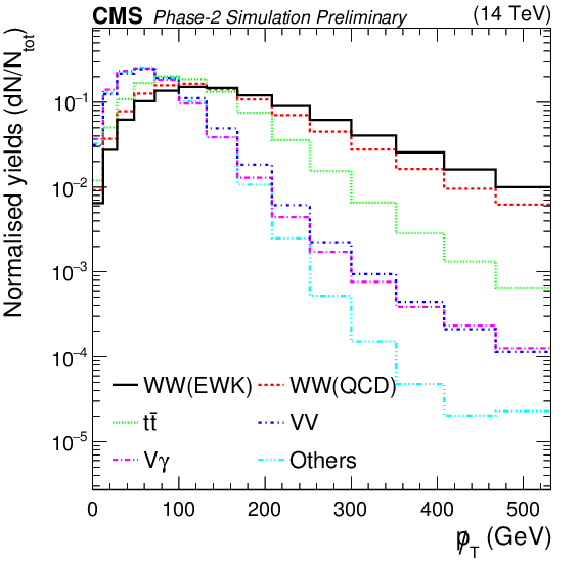
png pdf |
Figure 3-b:
Shape comparison for signal and background processes: Missing transverse momentum. |
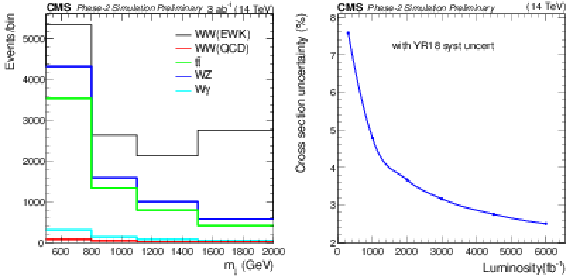
png pdf |
Figure 4:
Left: The distribution of the invariant mass of the two leading jets after the selection requirements for an integrated luminosity of 3000 fb−1. Right: The estimated uncertainty in the EWK W±W± cross section measurement as a function of the integrated luminosity (with YR18 systematic uncertainties). |
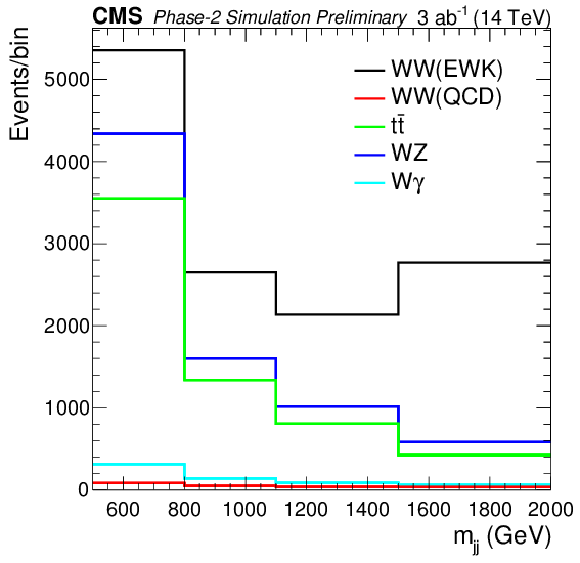
png pdf |
Figure 4-a:
The distribution of the invariant mass of the two leading jets after the selection requirements for an integrated luminosity of 3000 fb−1. |
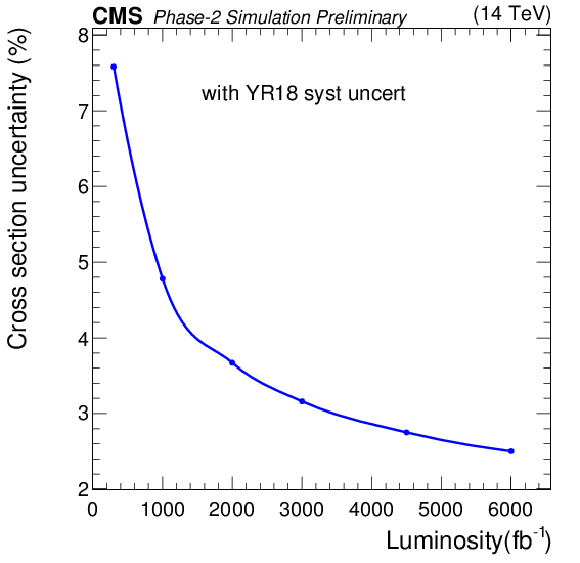
png pdf |
Figure 4-b:
The estimated uncertainty in the EWK W±W± cross section measurement as a function of the integrated luminosity (with YR18 systematic uncertainties). |

png pdf |
Figure 5:
The shape comparison of the LL, LT and TT components in the distribution of the azimuthal angle difference between the two leading jets for the VBS W±W± process for dijet invariant mass between 500 to 1100 GeV (left), and above 1100 GeV (right). |

png pdf |
Figure 5-a:
The shape comparison of the LL, LT and TT components in the distribution of the azimuthal angle difference between the two leading jets for the VBS W±W± process for dijet invariant mass between 500 to 1100 GeV. |
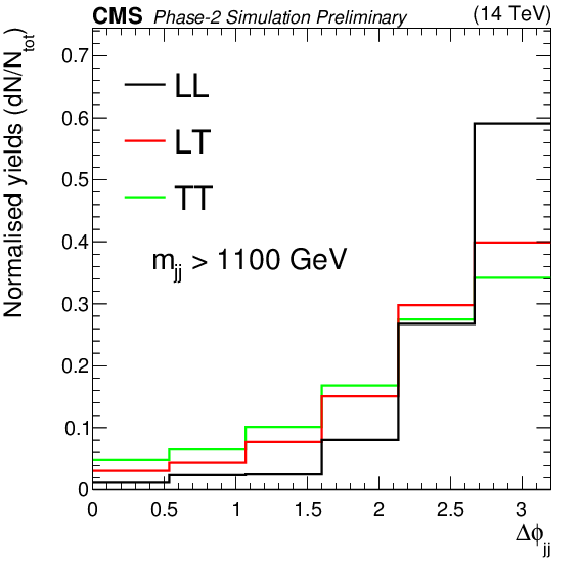
png pdf |
Figure 5-b:
The shape comparison of the LL, LT and TT components in the distribution of the azimuthal angle difference between the two leading jets for the VBS W±W± process for dijet invariant mass above 1100 GeV. |
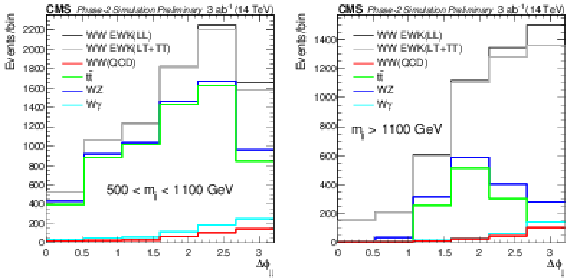
png pdf |
Figure 6:
Distributions of the azimuthal angle difference between the two leading jets for dijet invariant mass in the range 500-1100 GeV (left) and above 1100 GeV (right). Stacked contributions from the signal and various backgrounds are shown. |
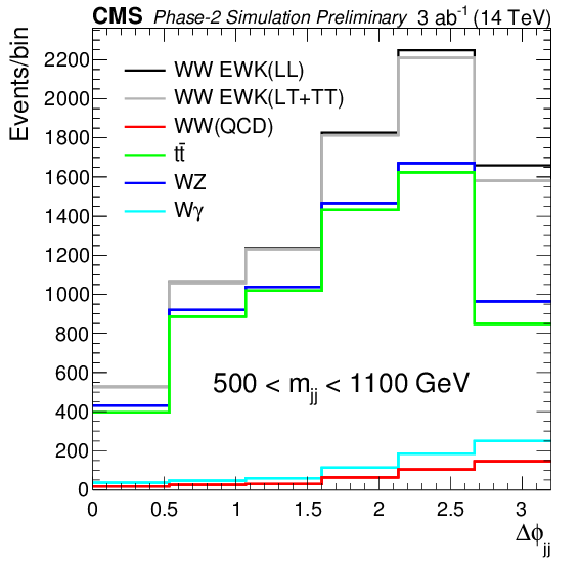
png pdf |
Figure 6-a:
Distribution of the azimuthal angle difference between the two leading jets for dijet invariant mass in the range 500-1100 GeV. Stacked contributions from the signal and various backgrounds are shown. |

png pdf |
Figure 6-b:
Distribution of the azimuthal angle difference between the two leading jets for dijet invariant mass above 1100 GeV. Stacked contributions from the signal and various backgrounds are shown. |
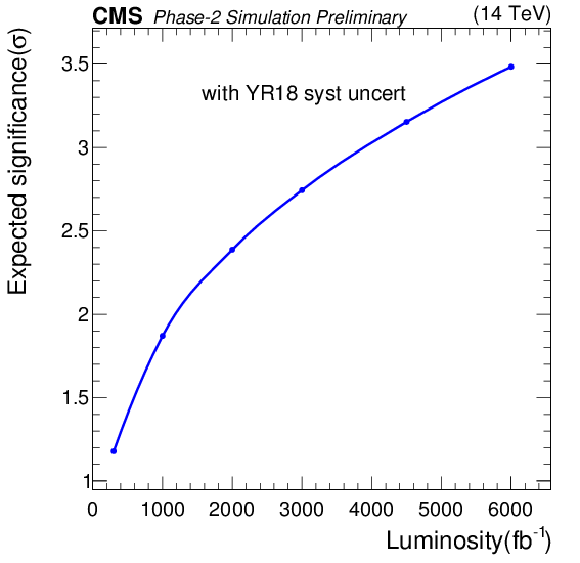
png pdf |
Figure 7:
Significance of the observation of the scattering of a pair of longitudinally polarized W bosons as a function of the integrated luminosity (with YR18 systematic uncertainties). |
| Tables | |
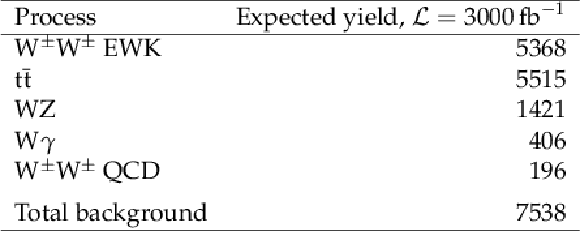
png pdf |
Table 1:
Expected yields for signal and background contributions for L= 3000 fb−1. |
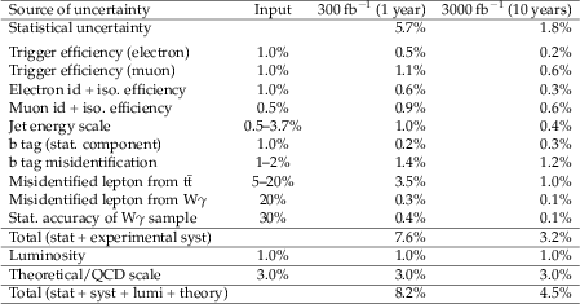
png pdf |
Table 2:
The systematic uncertainties considered in this analysis and their impact on the signal strength for two different integrated luminosities. For comparison, the expected statistical uncertainty is shown in the first row. |
| Summary |
| The prospects for the study of the W±W±jj final states produced via vector boson scattering (VBS) in pp collisions at the HL-LHC have been presented. The signal and background events were generated with a full simulation of the response of the Phase 2 upgraded CMS detector. The W bosons are detected via their leptonic decays into eν or μν. It is shown that the total experimental uncertainty in the VBS W±W± cross section measurement decreases by more than a factor of two when moving from a total integrated luminosity of 300 to 3000 fb−1, down to about 3%, and can be decreased even further if the results from CMS and ATLAS experiments are combined. The analysis demonstrates the sensitivity for measuring the longitudinally polarized component of the W±W± VBS production. The expected significance for an integrated luminosity of 3000 fb−1 is estimated to be 2.7 standard deviations, and can exceed a value of 3 for a combination of the CMS and ATLAS measurements. |
| References | ||||
| 1 | ATLAS Collaboration | Observation of a new particle in the search for the Standard Model Higgs boson with the ATLAS detector at the LHC | PLB 716 (2012) 1 | 1207.7214 |
| 2 | CMS Collaboration | Observation of a new boson at a mass of 125 GeV with the CMS experiment at the LHC | PLB 716 (2012) 30 | CMS-HIG-12-028 1207.7235 |
| 3 | CMS Collaboration | Observation of a new boson with mass near 125 GeV in pp collisions at √s= 7 and 8 TeV | JHEP 06 (2013) 081 | CMS-HIG-12-036 1303.4571 |
| 4 | J. Chang, K. Cheung, C.-T. Lu, and T.-C. Yuan | WW scattering in the era of post-Higgs-boson discovery | PRD 87 (2013) 093005 | 1303.6335 |
| 5 | D. Espriu and B. Yencho | Longitudinal WW scattering in light of the "Higgs boson" discovery | PRD 87 (2013) 055017 | 1212.4158 |
| 6 | CMS Collaboration | Observation of electroweak production of same-sign W boson pairs in the two jet and two same-sign lepton final state in proton-proton collisions at √s= 13 TeV | PRL 120 (2018) 081801 | CMS-SMP-17-004 1709.05822 |
| 7 | ATLAS Collaboration | Observation of electroweak production of a same-sign W boson pair in association with two jets in pp collisions at √s= 13 TeV with the ATLAS detector | Conference Note ATLAS-CONF-2018-030 | |
| 8 | CMS Collaboration | The CMS Experiment at the CERN LHC | JINST 3 (2008) S08004 | CMS-00-001 |
| 9 | G. Apollinari et al. | High-Luminosity Large Hadron Collider (HL-LHC) : preliminary design report | ||
| 10 | CMS Collaboration | Technical proposal for the Phase-II upgrade of the CMS detector | CERN-LHCC-2015-010, LHCC-P-008, CMS-TDR-15-02 | |
| 11 | CMS Collaboration | The Phase 2 upgrade of the CMS tracker | CERN-LHCC-2017-009, CMS-TDR-014 | |
| 12 | CMS Collaboration | The Phase 2 upgrade of the CMS barrel calorimeters Technical Design Report | CDS | |
| 13 | CMS Collaboration | The Phase 2 upgrade of the CMS endcap calorimeter | CDS | |
| 14 | CMS Collaboration | The Phase 2 upgrade of the CMS muon detectors | CDS | |
| 15 | CMS Collaboration | CMS Phase 2 object performance | CMS-PAS-FTR-18-012, in preparation | |
| 16 | J. Alwall et al. | The automated computation of tree-level and next-to-leading order differential cross sections, and their matching to parton shower simulations | JHEP 07 (2014) 079 | 1405.0301 |
| 17 | NNPDF Collaboration | Parton distributions for the LHC Run II | JHEP 04 (2015) 040 | 1410.8849 |
| 18 | P. Nason | A new method for combining NLO QCD with shower Monte Carlo algorithms | JHEP 11 (2004) 040 | hep-ph/0409146 |
| 19 | S. Alioli, P. Nason, C. Oleari, and E. Re | A general framework for implementing NLO calculations in shower Monte Carlo programs: the POWHEG BOX | JHEP 06 (2010) 043 | 1002.2581 |
| 20 | S. Alioli, P. Nason, C. Oleari, and E. Re | Vector boson plus one jet production in POWHEG | JHEP 01 (2011) 095 | 1009.5594 |
| 21 | S. Frixione, P. Nason, and C. Oleari | Matching NLO QCD computations with parton shower simulations: the POWHEG method | JHEP 11 (2007) 070 | 0709.2092 |
| 22 | J. Alwall et al. | The automated computation of tree-level and next-to-leading order differential cross sections, and their matching to parton shower simulations | JHEP 07 (2014) 079 | 1405.0301 |
| 23 | J. Alwall et al. | MadGraph 5: going beyond | JHEP 06 (2011) 128 | 1106.0522 |
| 24 | T. Sjostrand et al. | An introduction to PYTHIA 8.2 | CPC 191 (2015) 159 | 1410.3012 |
| 25 | CMS Collaboration | Event generator tunes obtained from underlying event and multiparton scattering measurements | EPJC 76 (2016) 155 | CMS-GEN-14-001 1512.00815 |
| 26 | GEANT4 Collaboration | GEANT4-- a simulation toolkit | NIMA 506 (2003) 250 | |
| 27 | M. Cacciari, G. P. Salam, and G. Soyez | FastJet user manual | EPJC 72 (2012) 1896 | 1111.6097 |
| 28 | M. Cacciari, G. P. Salam, and G. Soyez | The anti-kT jet clustering algorithm | JHEP 04 (2008) 063 | 0802.1189 |
| 29 | D. Bertolini, P. Harris, M. Low, and N. Tran | Pileup per particle identification | JHEP 10 (2014) 059 | 1407.6013 |
| 30 | CMS Collaboration | Identification of heavy-flavour jets with the CMS detector in pp collisions at 13 TeV | JINST 13 (2018) P05011 | CMS-BTV-16-002 1712.07158 |
| 31 | D. Guest et al. | Jet flavor classification in high-energy physics with deep neural networks | PRD 94 (2016) 112002 | |
| 32 | D. Rainwater, R. Szalapski, and D. Zeppenfeld | Probing color-singlet exchange in Z+2-jet events at the CERN LHC | PRD 54 (1996) 6680 | |

|
Compact Muon Solenoid LHC, CERN |

|

|

|

|

|

|